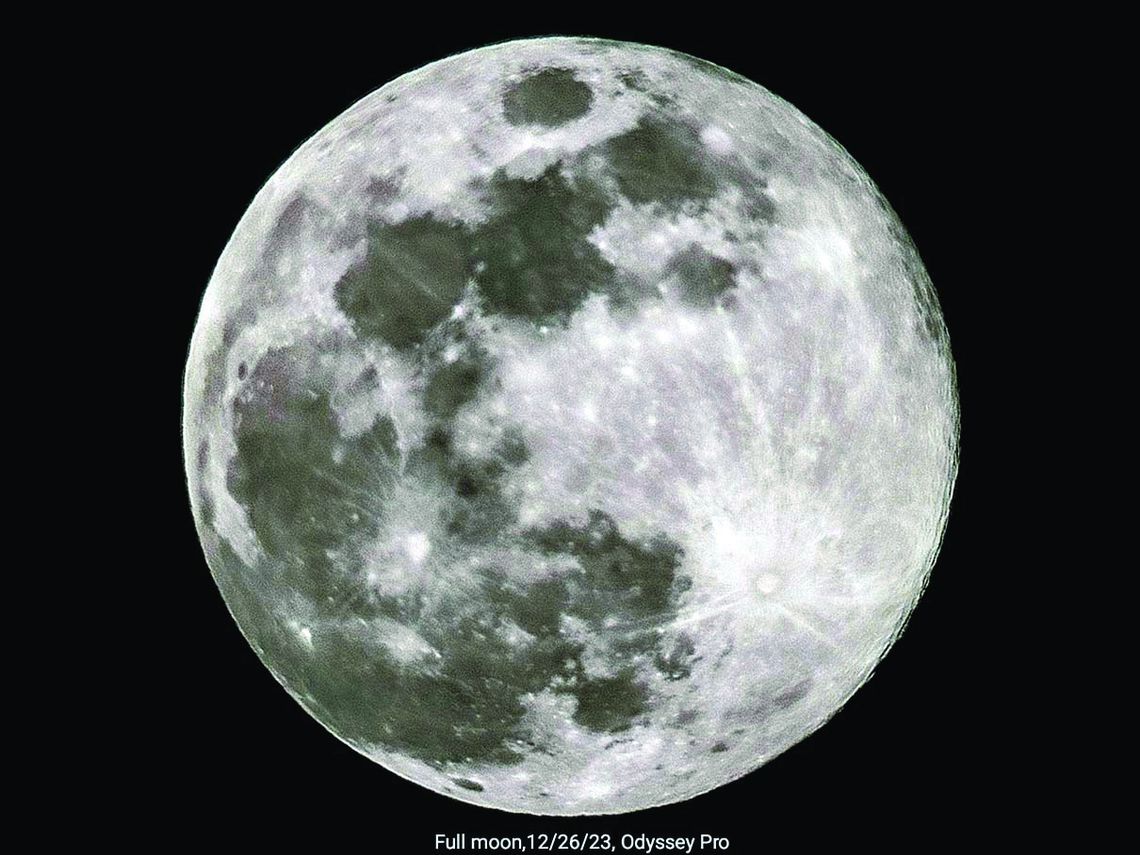For astronomers the full moon is normally a nuisance, something to be avoided. So, I thought we would change things up and give the moon its due.
I took the accompanying lunar image the day after Christmas 2023. I was a beta tester for a new Unistellar telescope aimed at entry-level astronomers and people who want to travel on an airline. It should fit in the overhead of commercial aircraft in its box. It’s called an Odyssey Pro and went on sale in early January. It’s not inexpensive but may be all the telescope most people need. It has auto collimation and auto focus, pretty cool tech for such a small scope, and very accurate.
Early calendars were based on the lunar cycle. The Chinese calendar, which is still in use, was designed around the full moon. It starts on the first January full moon and follows a 12-year cycle. Each year is represented by an animal.
Until rather recently the full moon was associated with people’s behavior. Lunatic was a word associated with odd behavior with Luna, the moon.
Greek mythology contains numerous stories about the full moon. The Greek goddess Selene was responsible for pulling the moon across Earth’s sky.
Many Native American Indian tribes had a special name for each full moon which we still use today. For example, the full moon in February is called the Snow Moon. March will be the Worm Moon. Per the Dakota Indian tribe, it refers to beetle larvae which emerge from thawing bark trees in March.
Modern science tells us the moon was formed during a collision, early in the solar system’s history, between the Earth and a Mars size object. Computer simulations show how this ripped out debris from deep in our planet which reshaped the Earth and created the moon from that orbiting debris cloud.
When the Apollo astronauts brought back lunar samples, they had almost the same chemical and isotopic signatures. Had the moon been captured from elsewhere in the solar system, that composition would be very different.
The name assigned to that rogue planet is Theia. During this terrible collision, nearly all of Earth and Theia melted and reformed as one body, with a small part spinning off to become the moon as we know it.
The moon hasn’t had volcanoes for billions of years, so its surface is mostly unchanged and the reason its crater impacts are so clear as seen from our planet. Because of that, we can tell a lot about what the early Earth looked like by studying the moon.
We’re quite lucky to have such a relatively large moon. Most planets wobble on their axis of rotation quite a bit over the eons. Our wobble is relatively minor because the moon acts as a stabilizing agent which greatly benefits biological life.
February things in the sky: The new moon is Feb. 9. If you’re brave enough to be outside with your telescope in February, this is the weekend for you as there will be no moon.
The moon and Jupiter are in conjunction (close together as seen from Earth) on Feb. 14. The moon will be 36% illuminated. They will be about 3 degrees apart in the hour before midnight.
Sunday Feb. 24 will be the full moon (Snow Moon).
%20Uploads/Boerne%20-%20Jack%20Estes%20Night%20Skies.jpg)
A lullaby to the full moon:
“Shining silver while the sun sleeps, the moon begins her silent creep.
A glowing disk that entices the tide, dancing with the sea as waves collide.
She comes to me most every night, bringing with her dreams of flight.
But must depart with the coming day, she walks in beauty and cannot stay.
Fear not we’ll meet once more, as the sun goes down she’ll be at my door.”
— Author unknown







Comment
Comments